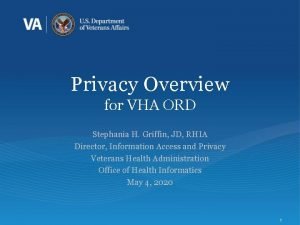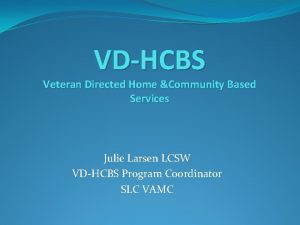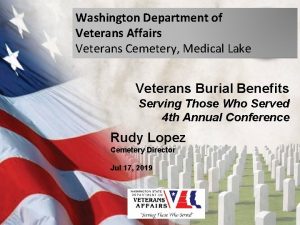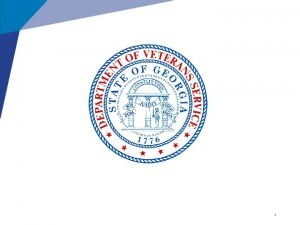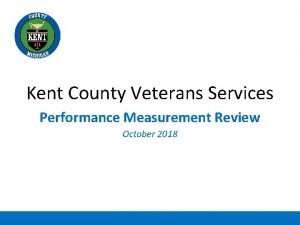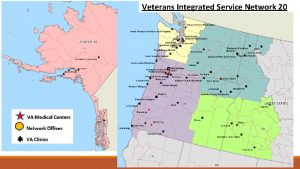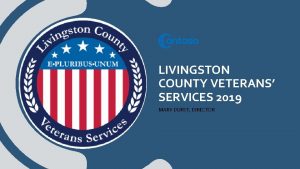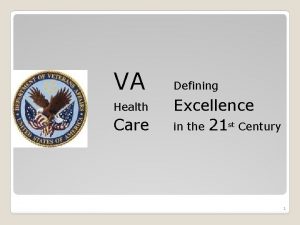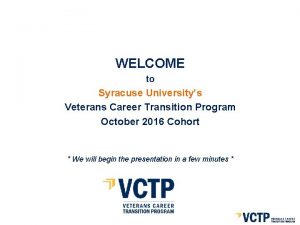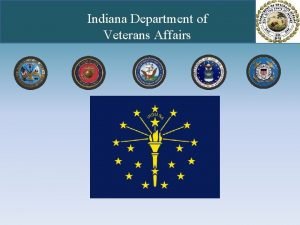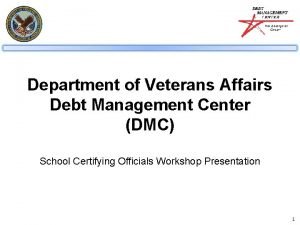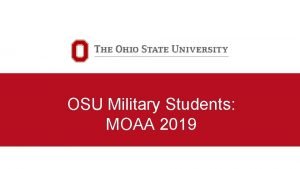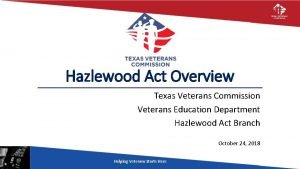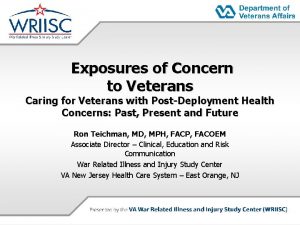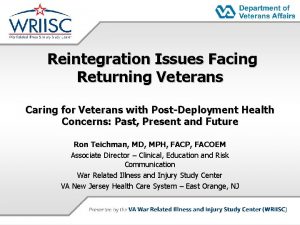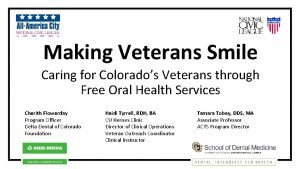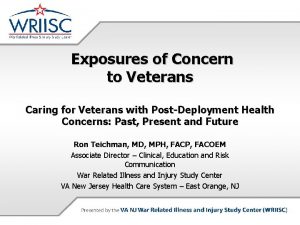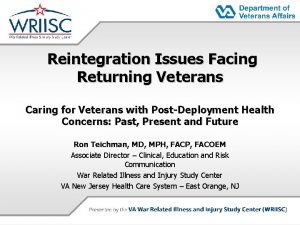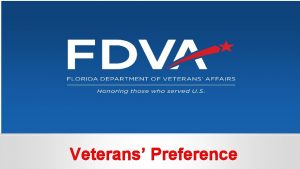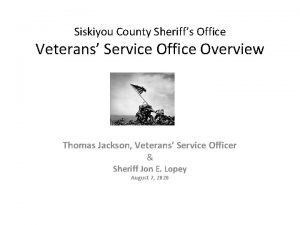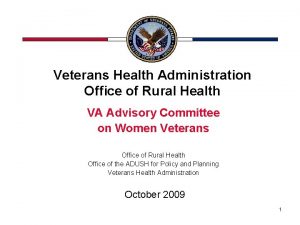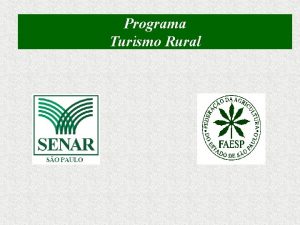Caring for Rural Veterans Overview of the Office


















































- Slides: 50

Caring for Rural Veterans Overview of the Office of Rural Health Thomas F. Klobucar, Ph. D Deputy Director #/Month 2015

Today’s presentation • • • Overview of the U. S. Department of Veterans Affairs Rural Veterans Office of Rural Health Environment VHA ORH Activities and Projects in Region A VETERANS HEALTH ADMINISTRATION 1

Overview VETERANS HEALTH ADMINISTRATION

Mission of the U. S. Department of Veterans Affairs (VA) “…to care for him who shall have borne the battle and for his widow and orphan…” - Abraham Lincoln, 1865 Photo by Jeff Kubina VETERANS HEALTH ADMINISTRATION 3

What is the U. S. Department of Veterans Affairs (VA)? • • Established in 1930 Elevated to Cabinet level in 1989 United States government’s 2 nd largest department after the Department of Defense Three components: – Veterans Health Administration (VHA) – Veterans Benefits Administration (VBA) – National Cemetery Administration (NCA) VETERANS HEALTH ADMINISTRATION 4

Organization of the U. S. Department of Veterans Affairs VETERANS HEALTH ADMINISTRATION 5

Organization of the Veterans Health Administration (VHA) VETERANS HEALTH ADMINISTRATION 6

Veterans Health Administration “Footprint” 167 Medical Centers 14 VA Health Care Centers 749 Community Based Outpatient Clinics 272 Other Outpatient Services Sites (including Mobile Clinics, Outreach Clinics) 370 Veterans Centers (including Mobile Veterans Centers VETERANS HEALTH ADMINISTRATION (VHA) OFFICE OF RURAL HEALTH (ORH) - 7

21 Veterans Integrated Service Networks (VISN) VETERANS HEALTH ADMINISTRATION 8

Office of Rural Health Policy Regions ORHP Region A overlaps with: • VISN 1 • VISN 2 • VISN 3 • VISN 4 • VISN 5 • VISN 6 • VISN 9 And contains • 45 VA Medical Centers • 160 VA Community Based Outpatient Clinics • 58 VA Outreach and Mobile Clinics VETERANS HEALTH ADMINISTRATION 9

Definition of Veteran for VA Purposes • Veteran is a person who: – Served in the active military, naval or air service – Was discharged or released under conditions other than dishonorable • Former or current Reservists, if they served for the full period for which they were called (excludes training purposes) • Former or current National Guard members if activated/mobilized by a Federal order VETERANS HEALTH ADMINISTRATION 10

Rural Veterans VETERANS HEALTH ADMINISTRATION

Eligibility for VHA Healthcare • Eligibility for VHA health care services depends on a number of qualifying factors, including: – The nature of a Veteran’s discharge from military service (e. g. , honorable, other than honorable, dishonorable) – Length of service – VA adjudicated disabilities (commonly referred to as “service-connected disabilities”) – Income level – Available VA resources VETERANS HEALTH ADMINISTRATION

As VA’s Rural Veteran Population Grows, VA Continues to Address Their Unique Needs • 22 million Veterans in the United States, 5. 2 million or 24 percent live in rural areas • Rural minority populations (of 5. 2 million) • 7% Women • 4. 7% African American • 2. 2% Hispanic • 1. 2% American Indian/Alaska Native • 0. 3% Asian American and Pacific Islanders • 33 percent, or 3. 0 million, are enrolled in VA’s health care system • 58% of all rural Veterans rely on VHA for health care • 36% of all urban Veterans rely on VHA VETERANS HEALTH ADMINISTRATION The most common outpatient diagnoses among rural Veterans are: ü High blood pressure ü Post-traumatic Stress Disorder (PTSD) and other mental health diagnoses ü Type II Diabetes ü Tobacco use disorder ü High blood cholesterol ü At least one serviceconnected disability 13

VA Patient Population and over 20 General Population by Age Group The VA Patient Population is Older than the General Population The age differential is more pronounced among Rural and Highly Rural Veterans 36% Highly Rural Urban Adult General Population 26% 27% 28% 57% 53% 46% 26% 19% 18% 15% 9% 11% 8% <40 VETERANS HEALTH ADMINISTRATION 9% 11% 40 -49 50 -64 65+

VHA Office of Rural Health VETERANS HEALTH ADMINISTRATION

VA’s Office of Rural Health (ORH) • • In 2006, Congress created the Office of Rural Health (ORH) by enacting Public Law 109 -461, Sec. 212 As the VA’s lead proponent for rural health, ORH works to see that America’s Veterans thrive in rural communities Mission: Improve the health and well-being of rural Veterans by increasing their access to care and services Works across VA and with external partners to develop policies, best practices and lessons learned to improve care and services for rural and highly rural Veterans VETERANS HEALTH ADMINISTRATION 16

Office of Rural Health components • Office of Rural Health (ORH) Central Office • • Provides national leadership on issues pertaining to rural veterans Administers special purpose appropriation and resources Provides technical assistance, project monitoring and performance analysis functions Coordinates Indian Health Service /VA Memorandum of Understanding (MOU) to promote access for American Indian/Alaska Native Veterans • Veterans Rural Health Resource Centers (VRHRC) • • Three regional centers: Togus Maine; Iowa City, Iowa; Salt Lake City, Utah Serve as rural health experts Field-based clinical and education laboratories for VA demonstration projects/pilot projects Provide programmatic support and technical assistance to funded VA partners • Veterans Integrated Service Network (VISN) Rural Consultants (VRC) • Serve as primary interface between ORH and VISN rural activities and projects • Develop rural health service plans based on VISN-wide needs assessments • Perform outreach to develop community relationships • Veterans’ Rural Health Advisory Committee (VRHAC) • Federal advisory committee to advise the Secretary of Veterans Affairs on health care issues affecting enrolled Veterans residing in rural areas • Chartered by VA Secretary in 2008 to bring the voice of rural Veterans and their supporters to the national stage • The appointed 16 person group’s recommendations inform priorities, policies and the focus of health care delivery projects in rural communities in service to Veterans VETERANS HEALTH ADMINISTRATION 17

Organization of the Office of Rural Health (ORH) VHA Assistant Deputy Under Secretary for Health for Policy and Planning Gina L. Capra, MPA Director Veterans Rural Health Resource Centers (VRHRC) Thomas F. Klobucar, Ph. D Deputy Director Secretary’s Veterans’ Rural Health Advisory Committee (VRHAC) Strategic Planner Staff Assistant Byron Bair, MD Director VRHRC Western Region Michael Ohl, MD Acting Director VRHRC Central Region 21 VISN Rural Consultants (VRC) 6 Analysts / HSS Budget Analyst Program Support Assistant Paul Hoffman, MD Director VRHRC Eastern Region VETERANS HEALTH ADMINISTRATION 18

Veterans Rural Health Resource Center, Iowa City, Iowa Veterans Rural Health Resource Center, Salt Lake City, Utah Veterans Rural Health Resource Center, Gainesville, Florida 19

2015 -19 Rural Health Strategic Plan • • The interagency supported FY 15 -FY 19 Rural Health Strategic Plan strives for healthy rural communities that support healthy Veterans ORH works across VA and with external partners to develop policies, best practices and lessons learned to improve care and services for rural and highly rural Veterans The top five states with the highest numbers of enrolled rural Veterans are Texas, North Carolina, Ohio, Pennsylvania and New York The top five states with the highest number of enrolled rural women Veterans are Texas, North Carolina, Florida, Georgia, California VETERANS HEALTH ADMINISTRATION Goal 1 Goal 2 Promote health and well-being in the rural Veteran population Generate and Diffuse knowledge regarding rural Veteran health ORH Mission Goal 3 Promote the health and well-being of rural and highly rural Veterans by improving access to quality health care and services. Strengthen community health care infrastructure where rural Veterans reside Goal 4 Inform health care policy that impacts rural Veterans and rural health care delivery ORH Five-Year Strategic Goals 2015 -2019 20

Environment VETERANS HEALTH ADMINISTRATION

Veterans Access, Choice and Accountability Act of 2014 • VA officially launched the Veterans Choice Program on November 5, 2014 in accordance with Public Law 113 -146 , August 7, 2014 • The Choice Act provides $10 B for community care if • VA cannot appoint within 30 days of the Veteran’s preferred date, or; • The Veteran resides more than 40 miles from their closest VA medical facility, or; • In cases of medical necessity • Choice Act allows VA to expand the availability of community care for Veterans through agreements with non-VA entities and providers • This authority sunsets in three years or when Veterans Choice Fund is expended VETERANS HEALTH ADMINISTRATION 22

Veterans Choice Act Rural Provisions Contained in HR 5404 and negotiated by VA with Congress (passed House & Senate): • Continued Project Access Closer to Home (ARCH) Pilot (Maine) • Enhanced collaboration with IHS to increase access, quality and coordination • Distinctions between use of mobile medical clinics and mobile vet centers Contained in the Omnibus (passed in December 2014): • Alaska and Maryland special payment provisions (beyond Medicare rates) • Additional $209 M for Choice Act medical staff hiring, facility expansion and Caregivers-providing stipends to families of seriously wounded Veterans • Inclusion appropriations for mandatory benefits (C&P; Readjustment; Indemnities) • 14. 98 M for Health Resources and Services Administration’s (HRSA) small, rural hospitals and $1 M for tele-health pilots • $10. 3 M for Dept. of Agriculture’s broadband expansion to rural areas for telemedicine and distance learning VETERANS HEALTH ADMINISTRATION 23

Veterans Choice Act in Region A All of Region A lies within Choice Act Region 1 VHA’s Third Party Administrator is Health Net Except for a small part of Western West Virginia which falls in Region 3 Third Party Administrator is Tri. West Interested Providers can use this link: http: //www. va. gov/opa/choiceact/for_providers. asp to get started VETERANS HEALTH ADMINISTRATION 24

Patient Centered Community Care (PC 3): A Community Contract Opportunity • • • PC 3 provides eligible Veterans access to health care through a comprehensive network of community-based, non-VA medical professionals Providers must meet VA quality standards when VA must supplement care outside its own facilities Provides eligible Veterans access to: – – – Primary care Inpatient specialty care Outpatient specialty care Mental health care Limited emergency care Limited newborn care for enrolled female Veterans following birth of a child VETERANS HEALTH ADMINISTRATION 25

VA’s Contractor Third Party Administrator Geographic Assignments VETERANS HEALTH ADMINISTRATION 26

Increasing Collaborations = Implications for Care Coordination and Health Information Exchange (HIE) • • Veterans have more opportunities to formally receive care outside VA Greater “dual-use” will increase demand for care coordination and HIE between VA and community providers – Dual-use is when Veterans use VA and non-VA health care services • • VA has a responsibility to ensure patients receive high quality care even when that care occurs outside VA facilities VA seeks to engage with community providers to deliver direct, query based and/or patient driven HIE or electronic care coordination How can we build off successes to date? What must we keep in mind for future? VETERANS HEALTH ADMINISTRATION 22

VHA ORH Activities and Projects in Region A VETERANS HEALTH ADMINISTRATION

VHA Virtual Lifetime Electronic Record (VLER) Electronic Health Information Exchange Partners VETERANS HEALTH ADMINISTRATION http: //www. va. gov/vler/ 29

Veteran Health Information Exchange Products The Veteran (HIE)/VLER Health Program includes 2 options for sharing health data • Exchange (Provider to Provider Direct) – allows VA providers and community providers to query and retrieve health information with each other’s organizations – Standards Based Exchange of relevant clinical information – 42 Partners in production, in 40 communities • Direct Secure Messaging– allows VA patients to send and receive health information to community partners via secure email through a trusted Network – Access through enterprise-wide web application and there is no installation or support required by the VA healthcare System – 18 Partners in production VETERANS HEALTH ADMINISTRATION http: //www. va. gov/vler/ 30

What Does Exchange Look Like? Health Bank or PHR Support Organization State and Local Gov Community Health Centers SSA Community #1 Shared trust framework and rules of the road Acronym Key -CMS – Centers for Medicare & Medicaid Services -Do. D – Department of Defense -PHR – Personal Health Record -SSA – Social Security Administration -VA – Department of Veterans Affairs VA Do. D Labs CMS Integrated Delivery System Pharmacies ty #2 uni Comm The Internet VETERANS HEALTH ADMINISTRATION Powered by • Healtheway DOES NOT maintain any data • Healtheway IS NOT a gateway or connection point Common standards, specifications and policies enforced through Data Use & Reciprocal Support Agreement (DURSA) 31

Direct Secure Messaging 1. Direct leads to greater workflow efficiencies by providing a low cost alternative to faxing and scanning 2. Direct is a simple and secure way to send messages and medical information to other providers, enhancing VHA clinicians ability to collaborate for Veteran patient care 3. Direct is built on well-established Internet standards, commonly used for secure email communications 4. Direct is required for Meaningful Use 2014 Certification which is facilitating national adoption VETERANS HEALTH ADMINISTRATION http: //www. va. gov/vler/ 32

Veteran Initiated Electronic Care Coordination (VIECC) Pilot • • Goal 1: Improve quality and care coordination for rural Veterans receiving VA care and care outside of VA (dual use) by using VA’s My Healthe. Vet Blue Button capability to facilitate transfer of health information to non-VA providers for healthcare Goal 2: Evaluate if availability of VA health information at non-VA points of care/appointment impacts care received (medication discrepancies, duplicative tests) VETERANS HEALTH ADMINISTRATION 33

VIECC Agencies and Sites National multi-site, multi-agency collaboration VETERANS HEALTH ADMINISTRATION 34

My Healthe. Vet and VA Blue Button • My Healthe. Vet- VA’s personal health record portal ww. myhealth. va. gov • VA Blue Button – Veterans can download, view, and transmit (in testing) their health information from My Healthe. Vet • VA Health Summary – Interoperable document available in both machine (xml) and human (pdf) readable formats VETERANS HEALTH ADMINISTRATION 35

VIECC Community Provider Feedback “ 90 percent endorsed that information from the Continuity of Care Document improved my ability to have an accurate medication list and make treatment decisions about medications. ” (n=71) VETERANS HEALTH ADMINISTRATION “ 50. 8 percent of providers endorsed “I did not order some laboratory tests or other Procedures because of information available on the VA Continuity of Care Document. ” (n=65) 36

ORH Collaborative Workforce Initiatives • Specialty Care Access Network – Extension for Community Healthcare Outcomes (SCANECHO) – Program leverages telehealth technology to equip rural VA providers to manage patients with chronic conditions closer to home • Geri Scholars – Aided geriatric health care providers in treating the special needs of older Veterans – Served 185 facilities and 1, 356 staff (e. g. , primary care providers and pharmacy, social work, psychology staff that support the care of older Veterans) • Rural Provider and Staff Training Initiative (RPSTI) – 21 VHA clinical sites serving rural Veterans where innovative training and educational programs were developed for existing health care providers and clinic staff – Training topics included palliative care, dementia, polypharmacy and substance use disorders – As of FY 2014, 4, 962 clinicians and staff have been trained VETERANS HEALTH ADMINISTRATION 37

ORH Collaborative Workforce Initiatives (continued) • The Rural Health Training Initiative (RHTI) – Clinical education program launched in 2012 – 420 clinicians have trained at 22 VHA rural sites of care • Telehealth projects – ORH partners with Office of Telehealth Services to fund telehealth projects such to provide services to rural Veterans where provider shortages or access to care may be a challenge • Requests for Proposals – ORH funded more than 1, 850 providers and non-clinical service providers in rural communities (FY 2015) VETERANS HEALTH ADMINISTRATION 38

VA-Indian Health Service Partnership and National Reimbursement Program • • October 2010: the VA Under Secretary for Health, and the IHS Director signed a Memorandum of Understanding Goals: – Increase access and quality of care for American Indian/Alaska Native (AI/AN) Veterans – Improve health-promotion & disease-prevention – Encourage patient-centered collaboration and communication – Consult with tribes at the regional and local levels – Ensure appropriate resources for services for AIAN Veterans • • December 2012: VA-IHS National Reimbursement Agreement signed August 2015: Veterans Access, Choice, and Accountability Act Section 102 requires increased outreach, improved metrics and further study of reimbursement agreements across IHS programs and VA VETERANS HEALTH ADMINISTRATION The MOU and Agreements: ü Promote quality health care through collaborative relationships and agreements ü Focus on increasing coordination, collaboration, and resource-sharing for eligible AI/AN Veterans 39

Tribal Health Program and Indian Health Service Facilities Participating in the Reimbursement Program, FY 2014 Source: VA Chief Business Office Reimbursement Reports, FY 2014 VETERANS HEALTH ADMINISTRATION 40

VHA’s Rural Veterans in SORH Region A • • • 513, 000 total rural Veterans enrolled in VA in SORH Region A 28 percent of enrolled Veterans in SORH Region A live in rural or high rural areas – Largest enrolled rural Veteran population: Pennsylvania (118, 383) – Smallest enrolled rural Veteran population: Rhode Island (2, 069) 58 percent of the rural enrolled population is >65 years old – 53 percent of the enrolled urban Veteran population is >65 years old 36 percent of enrolled rural Veterans have a service connected disability – Same rate in urban population 11 percent served in the recent Iraq or Afghanistan conflicts – 13 percent in the urban Veteran population 6 percent are female – 7 percent in urban areas VETERANS HEALTH ADMINISTRATION 41

ORH Initiatives in SORH Region A • • • 218 funded initiatives since FY 2014 $91 million invested to increase rural Veteran access to care 180, 000 total Veterans impacted – 160, 000 rural Veterans impacted • Projects increased access to the following services: – – – – – Mental health Home based primary care Pharmacy Women’s health services Nutrition and wellness Geriatrics Telehealth Chronic pain treatment Audiology VETERANS HEALTH ADMINISTRATION 42

Noteworthy ORH Initiatives in SORH Region A • Project Access Received Closer to Home (ARCH) (ME) – Legislatively mandated community care program active in 5 states that includes care coordination – Partnered with Cary Medical Center • Maternity Care Coordination for Rural Women Veterans (MA) – Network wide maternity care support including collaboration with community providers • Tele. Quit Tobacco Cessation Program (NY) – Increase access to tobacco cessation services through personalized telephonebased interventions VETERANS HEALTH ADMINISTRATION 43

Noteworthy ORH Initiatives in SORH Region A (continued) • Rural Provider and Staff Training Initiative (RPSTI) (VT) – Providers are trained to improve posttraumatic stress disorder care for Veterans • Home Based Cardiac Rehabilitation (NH, CT) – “Promising practice” where Veteran receives personal telephone-based cardiac rehabilitation services in the home • Telemental Health at Staunton, Wytheville, and Lynchburg Clinics (VA) – Provides mental health care to rural Veterans at the most accessible point of contact VETERANS HEALTH ADMINISTRATION 44

Where are We Headed? Eye on the Current…and Future Environment • Affordable Care Act – Medicaid expansion – Health Insurance Marketplace Outreach and Enrollment • Veterans Access, Choice and Accountability Act of 2014 (VACAA, “Veterans Choice Act”) – Geographic access: 40 -miles or more – Health care access point expansion mechanisms – Leveraging federal health partners: Indian Health Service/Tribal Health Programs, Native Hawaiian Health • Rural Issues and Trends – Population Migration and Demographics – Workforce Development – Technology Impact & Effective Use of Resources VETERANS HEALTH ADMINISTRATION

Thank you. Discussion/questions? For additional information, please contact: Thomas Klobucar, Ph. D Deputy Director, Office of Rural Health Thomas. Klobucar@va. gov Adam Bluth Senior Analyst, Office of Rural Health Adam. Bluth@va. gov Visit ruralhealth. va. gov Watch http: //youtu. be/yy. Ij. KAa-kv 0 Subscribe http: //www. ruralhealth. va. gov/news VHA Office of Rural Health – 90 K Street Room 703, Washington, DC 20002 Phone: 202. 632. 8615 VETERANS HEALTH ADMINISTRATION 46

Supplement VETERANS HEALTH ADMINISTRATION

Definition of Urban, Rural and Highly Rural • VHA uses the Rural Urban Commuting Area (RUCA) system to determine rurality – Developed and used by the US Department of Agriculture (USDA) and the US Department of Health and Human Services (HHS) – Widely accepted and adaptable, very precise • RUCA “tiers” determine rurality – RUCA tiers are grouped into urban (U), rural (R) and highly rural (H) categories using the scheme suggested by Washington State Department of Health. VETERANS HEALTH ADMINISTRATION

Map 2. Approved Urban, Rural and Highly Rural Areas VETERANS HEALTH ADMINISTRATION 49 49
 Actual caring occasion
Actual caring occasion Va form 10-250
Va form 10-250 Va's maximum loan amount for 100 financing is $144 000
Va's maximum loan amount for 100 financing is $144 000 Veterans administration daytona beach
Veterans administration daytona beach Veterans directed home and community based care
Veterans directed home and community based care Medical lake veterans cemetery
Medical lake veterans cemetery Gdvs locations
Gdvs locations Kent county veterans services
Kent county veterans services Visn 20
Visn 20 Veoa vs vra
Veoa vs vra Livingston county veterans services
Livingston county veterans services Mechling shakley veterans center
Mechling shakley veterans center Veterans employment initiative
Veterans employment initiative Veterans directed home and community based care
Veterans directed home and community based care Veterans health administration organizational chart
Veterans health administration organizational chart Parabat veterans organisation
Parabat veterans organisation Uccs lane center
Uccs lane center Goldman sachs veterans
Goldman sachs veterans Riverside county veterans services
Riverside county veterans services Maryland commitment to veterans
Maryland commitment to veterans Utsa va certification form
Utsa va certification form Syracuse veterans transition program
Syracuse veterans transition program Indiana disabled veteran license plate
Indiana disabled veteran license plate Va dmc
Va dmc Osu military and veterans services
Osu military and veterans services Tvc veterans education
Tvc veterans education Referatmarkeringar
Referatmarkeringar Tack för att ni har lyssnat
Tack för att ni har lyssnat Vanlig celldelning
Vanlig celldelning Verifikationsplan
Verifikationsplan Tryck formel
Tryck formel Presentera för publik crossboss
Presentera för publik crossboss Rbk-mätning
Rbk-mätning Förklara densitet för barn
Förklara densitet för barn Elektronik för barn
Elektronik för barn Var 1721 för stormaktssverige
Var 1721 för stormaktssverige Tack för att ni har lyssnat
Tack för att ni har lyssnat Smärtskolan kunskap för livet
Smärtskolan kunskap för livet Epiteltyper
Epiteltyper Trög för kemist
Trög för kemist Tät skog karttecken
Tät skog karttecken Mindre än tecken
Mindre än tecken Delegerande ledarskap
Delegerande ledarskap Toppslätskivling dos
Toppslätskivling dos Returpilarna
Returpilarna Kassaregister ideell förening
Kassaregister ideell förening Borra hål för knoppar
Borra hål för knoppar Bris för vuxna
Bris för vuxna Mat för unga idrottare
Mat för unga idrottare Offentlig förvaltning
Offentlig förvaltning Argument för teckenspråk som minoritetsspråk
Argument för teckenspråk som minoritetsspråk

